Leadership Report: Comparing Leadership Theories and Practices
VerifiedAdded on 2020/05/28
|10
|2105
|70
Report
AI Summary
This leadership assignment analyzes different managerial behaviors and leadership styles through case studies. The first part of the assignment compares the people-centric approach of Ben Samuels with the disruptive leadership style of Phil, examining their impact on employee retention and performance. The second part presents two case studies. Case 1 evaluates the effectiveness of Kathy's group decision-making process regarding employee vacation schedules and productivity incentives, focusing on employee participation. Case 2 examines Marsha Brown's transformational and charismatic leadership at Metro Bank, highlighting her strategies to improve employee morale, productivity, and managerial talent development. The assignment also includes the student's perspective on how they would manage a plant, and the author provides detailed analysis supported by relevant academic references.

Running head: LEADERSHIP
Leadership
Name of Student:
Name of University:
Author’s Note:
Leadership
Name of Student:
Name of University:
Author’s Note:
Paraphrase This Document
Need a fresh take? Get an instant paraphrase of this document with our AI Paraphraser
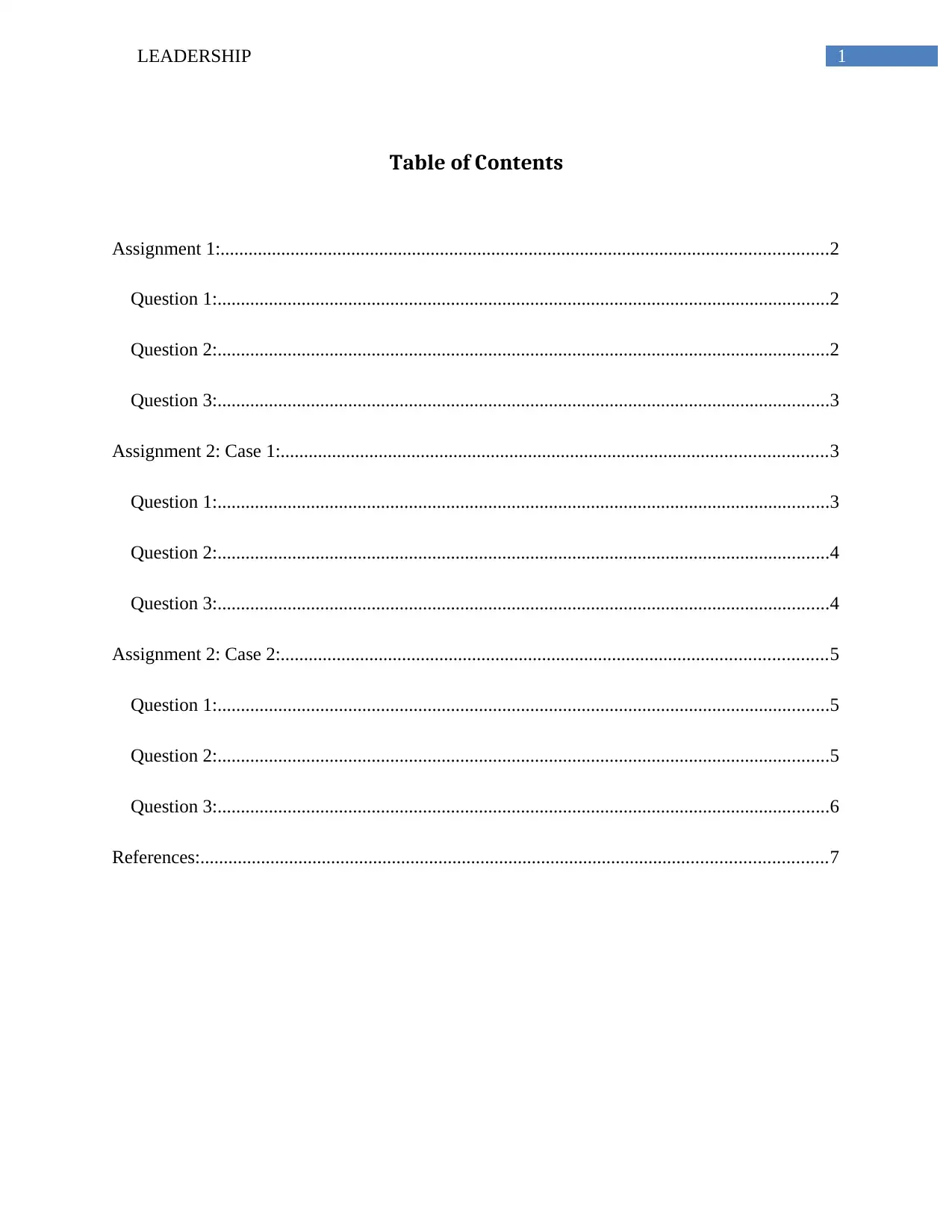
1LEADERSHIP
Table of Contents
Assignment 1:..................................................................................................................................2
Question 1:...................................................................................................................................2
Question 2:...................................................................................................................................2
Question 3:...................................................................................................................................3
Assignment 2: Case 1:.....................................................................................................................3
Question 1:...................................................................................................................................3
Question 2:...................................................................................................................................4
Question 3:...................................................................................................................................4
Assignment 2: Case 2:.....................................................................................................................5
Question 1:...................................................................................................................................5
Question 2:...................................................................................................................................5
Question 3:...................................................................................................................................6
References:......................................................................................................................................7
Table of Contents
Assignment 1:..................................................................................................................................2
Question 1:...................................................................................................................................2
Question 2:...................................................................................................................................2
Question 3:...................................................................................................................................3
Assignment 2: Case 1:.....................................................................................................................3
Question 1:...................................................................................................................................3
Question 2:...................................................................................................................................4
Question 3:...................................................................................................................................4
Assignment 2: Case 2:.....................................................................................................................5
Question 1:...................................................................................................................................5
Question 2:...................................................................................................................................5
Question 3:...................................................................................................................................6
References:......................................................................................................................................7
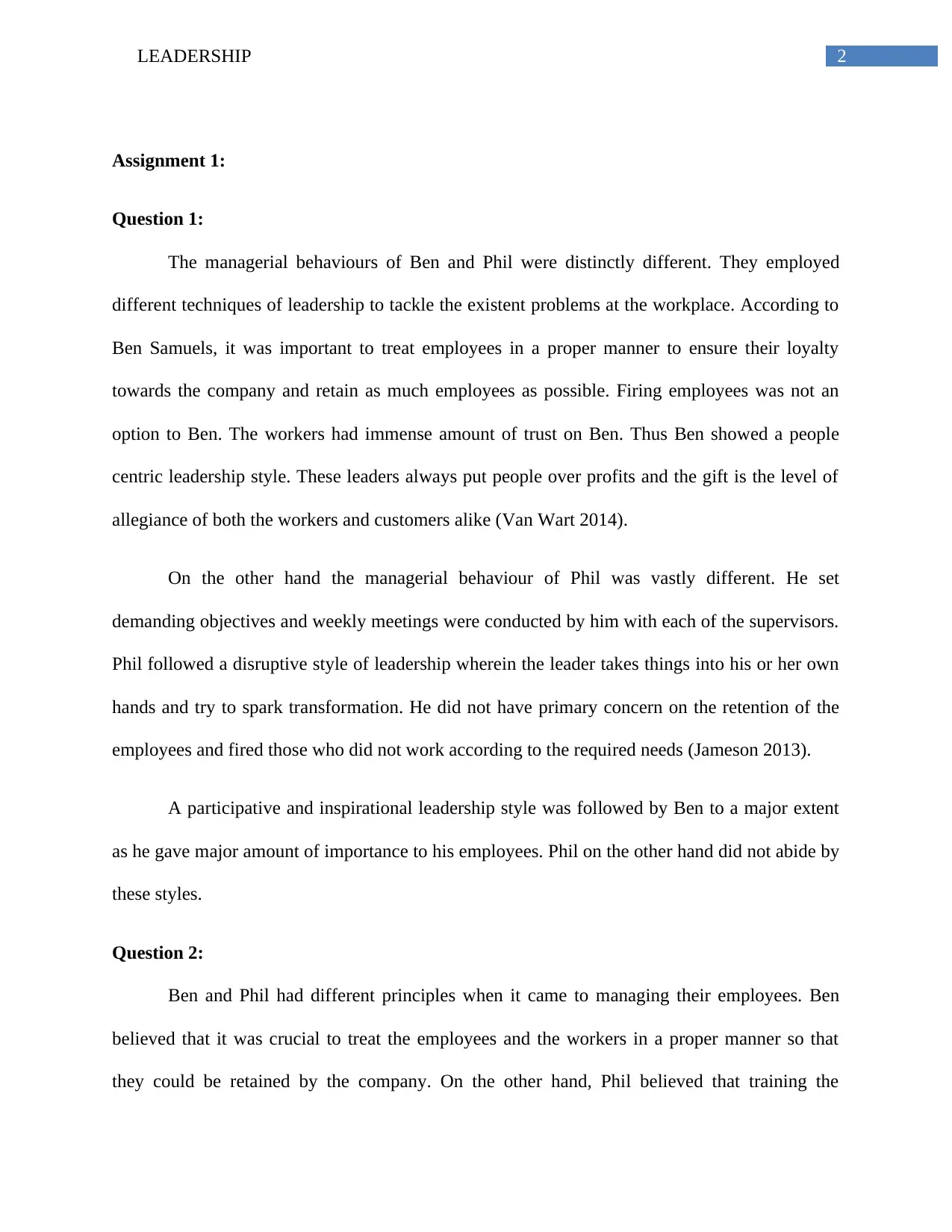
2LEADERSHIP
Assignment 1:
Question 1:
The managerial behaviours of Ben and Phil were distinctly different. They employed
different techniques of leadership to tackle the existent problems at the workplace. According to
Ben Samuels, it was important to treat employees in a proper manner to ensure their loyalty
towards the company and retain as much employees as possible. Firing employees was not an
option to Ben. The workers had immense amount of trust on Ben. Thus Ben showed a people
centric leadership style. These leaders always put people over profits and the gift is the level of
allegiance of both the workers and customers alike (Van Wart 2014).
On the other hand the managerial behaviour of Phil was vastly different. He set
demanding objectives and weekly meetings were conducted by him with each of the supervisors.
Phil followed a disruptive style of leadership wherein the leader takes things into his or her own
hands and try to spark transformation. He did not have primary concern on the retention of the
employees and fired those who did not work according to the required needs (Jameson 2013).
A participative and inspirational leadership style was followed by Ben to a major extent
as he gave major amount of importance to his employees. Phil on the other hand did not abide by
these styles.
Question 2:
Ben and Phil had different principles when it came to managing their employees. Ben
believed that it was crucial to treat the employees and the workers in a proper manner so that
they could be retained by the company. On the other hand, Phil believed that training the
Assignment 1:
Question 1:
The managerial behaviours of Ben and Phil were distinctly different. They employed
different techniques of leadership to tackle the existent problems at the workplace. According to
Ben Samuels, it was important to treat employees in a proper manner to ensure their loyalty
towards the company and retain as much employees as possible. Firing employees was not an
option to Ben. The workers had immense amount of trust on Ben. Thus Ben showed a people
centric leadership style. These leaders always put people over profits and the gift is the level of
allegiance of both the workers and customers alike (Van Wart 2014).
On the other hand the managerial behaviour of Phil was vastly different. He set
demanding objectives and weekly meetings were conducted by him with each of the supervisors.
Phil followed a disruptive style of leadership wherein the leader takes things into his or her own
hands and try to spark transformation. He did not have primary concern on the retention of the
employees and fired those who did not work according to the required needs (Jameson 2013).
A participative and inspirational leadership style was followed by Ben to a major extent
as he gave major amount of importance to his employees. Phil on the other hand did not abide by
these styles.
Question 2:
Ben and Phil had different principles when it came to managing their employees. Ben
believed that it was crucial to treat the employees and the workers in a proper manner so that
they could be retained by the company. On the other hand, Phil believed that training the
⊘ This is a preview!⊘
Do you want full access?
Subscribe today to unlock all pages.

Trusted by 1+ million students worldwide
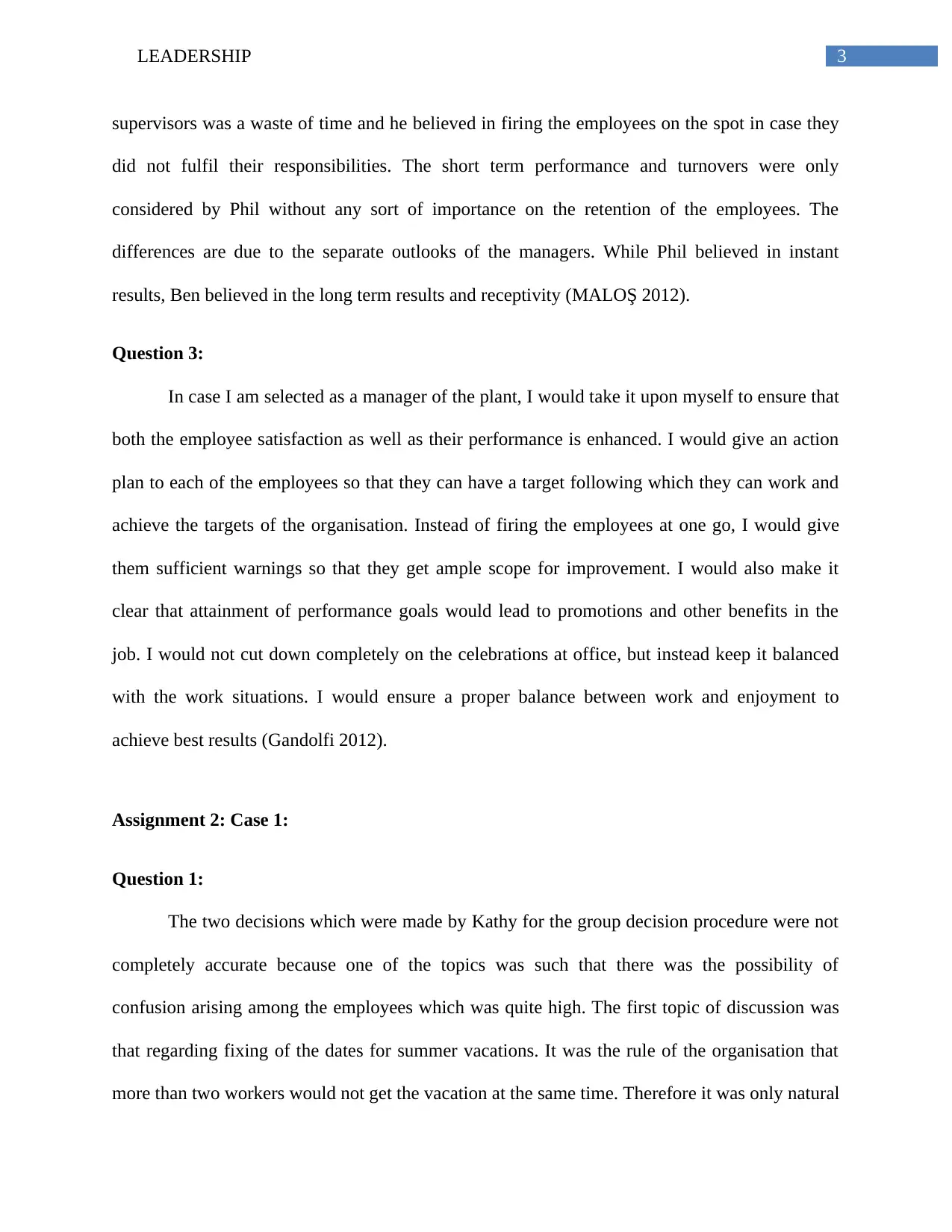
3LEADERSHIP
supervisors was a waste of time and he believed in firing the employees on the spot in case they
did not fulfil their responsibilities. The short term performance and turnovers were only
considered by Phil without any sort of importance on the retention of the employees. The
differences are due to the separate outlooks of the managers. While Phil believed in instant
results, Ben believed in the long term results and receptivity (MALOŞ 2012).
Question 3:
In case I am selected as a manager of the plant, I would take it upon myself to ensure that
both the employee satisfaction as well as their performance is enhanced. I would give an action
plan to each of the employees so that they can have a target following which they can work and
achieve the targets of the organisation. Instead of firing the employees at one go, I would give
them sufficient warnings so that they get ample scope for improvement. I would also make it
clear that attainment of performance goals would lead to promotions and other benefits in the
job. I would not cut down completely on the celebrations at office, but instead keep it balanced
with the work situations. I would ensure a proper balance between work and enjoyment to
achieve best results (Gandolfi 2012).
Assignment 2: Case 1:
Question 1:
The two decisions which were made by Kathy for the group decision procedure were not
completely accurate because one of the topics was such that there was the possibility of
confusion arising among the employees which was quite high. The first topic of discussion was
that regarding fixing of the dates for summer vacations. It was the rule of the organisation that
more than two workers would not get the vacation at the same time. Therefore it was only natural
supervisors was a waste of time and he believed in firing the employees on the spot in case they
did not fulfil their responsibilities. The short term performance and turnovers were only
considered by Phil without any sort of importance on the retention of the employees. The
differences are due to the separate outlooks of the managers. While Phil believed in instant
results, Ben believed in the long term results and receptivity (MALOŞ 2012).
Question 3:
In case I am selected as a manager of the plant, I would take it upon myself to ensure that
both the employee satisfaction as well as their performance is enhanced. I would give an action
plan to each of the employees so that they can have a target following which they can work and
achieve the targets of the organisation. Instead of firing the employees at one go, I would give
them sufficient warnings so that they get ample scope for improvement. I would also make it
clear that attainment of performance goals would lead to promotions and other benefits in the
job. I would not cut down completely on the celebrations at office, but instead keep it balanced
with the work situations. I would ensure a proper balance between work and enjoyment to
achieve best results (Gandolfi 2012).
Assignment 2: Case 1:
Question 1:
The two decisions which were made by Kathy for the group decision procedure were not
completely accurate because one of the topics was such that there was the possibility of
confusion arising among the employees which was quite high. The first topic of discussion was
that regarding fixing of the dates for summer vacations. It was the rule of the organisation that
more than two workers would not get the vacation at the same time. Therefore it was only natural
Paraphrase This Document
Need a fresh take? Get an instant paraphrase of this document with our AI Paraphraser
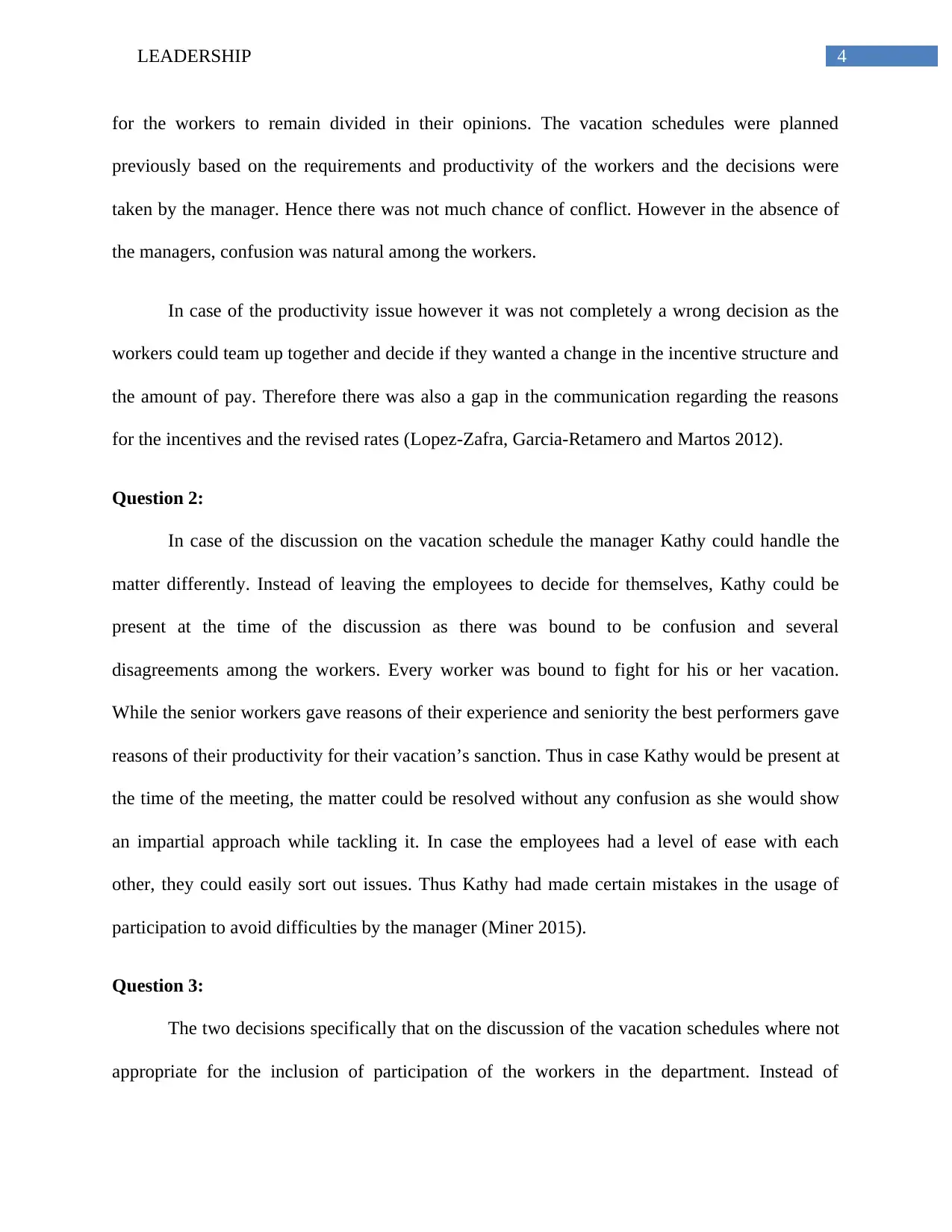
4LEADERSHIP
for the workers to remain divided in their opinions. The vacation schedules were planned
previously based on the requirements and productivity of the workers and the decisions were
taken by the manager. Hence there was not much chance of conflict. However in the absence of
the managers, confusion was natural among the workers.
In case of the productivity issue however it was not completely a wrong decision as the
workers could team up together and decide if they wanted a change in the incentive structure and
the amount of pay. Therefore there was also a gap in the communication regarding the reasons
for the incentives and the revised rates (Lopez-Zafra, Garcia-Retamero and Martos 2012).
Question 2:
In case of the discussion on the vacation schedule the manager Kathy could handle the
matter differently. Instead of leaving the employees to decide for themselves, Kathy could be
present at the time of the discussion as there was bound to be confusion and several
disagreements among the workers. Every worker was bound to fight for his or her vacation.
While the senior workers gave reasons of their experience and seniority the best performers gave
reasons of their productivity for their vacation’s sanction. Thus in case Kathy would be present at
the time of the meeting, the matter could be resolved without any confusion as she would show
an impartial approach while tackling it. In case the employees had a level of ease with each
other, they could easily sort out issues. Thus Kathy had made certain mistakes in the usage of
participation to avoid difficulties by the manager (Miner 2015).
Question 3:
The two decisions specifically that on the discussion of the vacation schedules where not
appropriate for the inclusion of participation of the workers in the department. Instead of
for the workers to remain divided in their opinions. The vacation schedules were planned
previously based on the requirements and productivity of the workers and the decisions were
taken by the manager. Hence there was not much chance of conflict. However in the absence of
the managers, confusion was natural among the workers.
In case of the productivity issue however it was not completely a wrong decision as the
workers could team up together and decide if they wanted a change in the incentive structure and
the amount of pay. Therefore there was also a gap in the communication regarding the reasons
for the incentives and the revised rates (Lopez-Zafra, Garcia-Retamero and Martos 2012).
Question 2:
In case of the discussion on the vacation schedule the manager Kathy could handle the
matter differently. Instead of leaving the employees to decide for themselves, Kathy could be
present at the time of the discussion as there was bound to be confusion and several
disagreements among the workers. Every worker was bound to fight for his or her vacation.
While the senior workers gave reasons of their experience and seniority the best performers gave
reasons of their productivity for their vacation’s sanction. Thus in case Kathy would be present at
the time of the meeting, the matter could be resolved without any confusion as she would show
an impartial approach while tackling it. In case the employees had a level of ease with each
other, they could easily sort out issues. Thus Kathy had made certain mistakes in the usage of
participation to avoid difficulties by the manager (Miner 2015).
Question 3:
The two decisions specifically that on the discussion of the vacation schedules where not
appropriate for the inclusion of participation of the workers in the department. Instead of
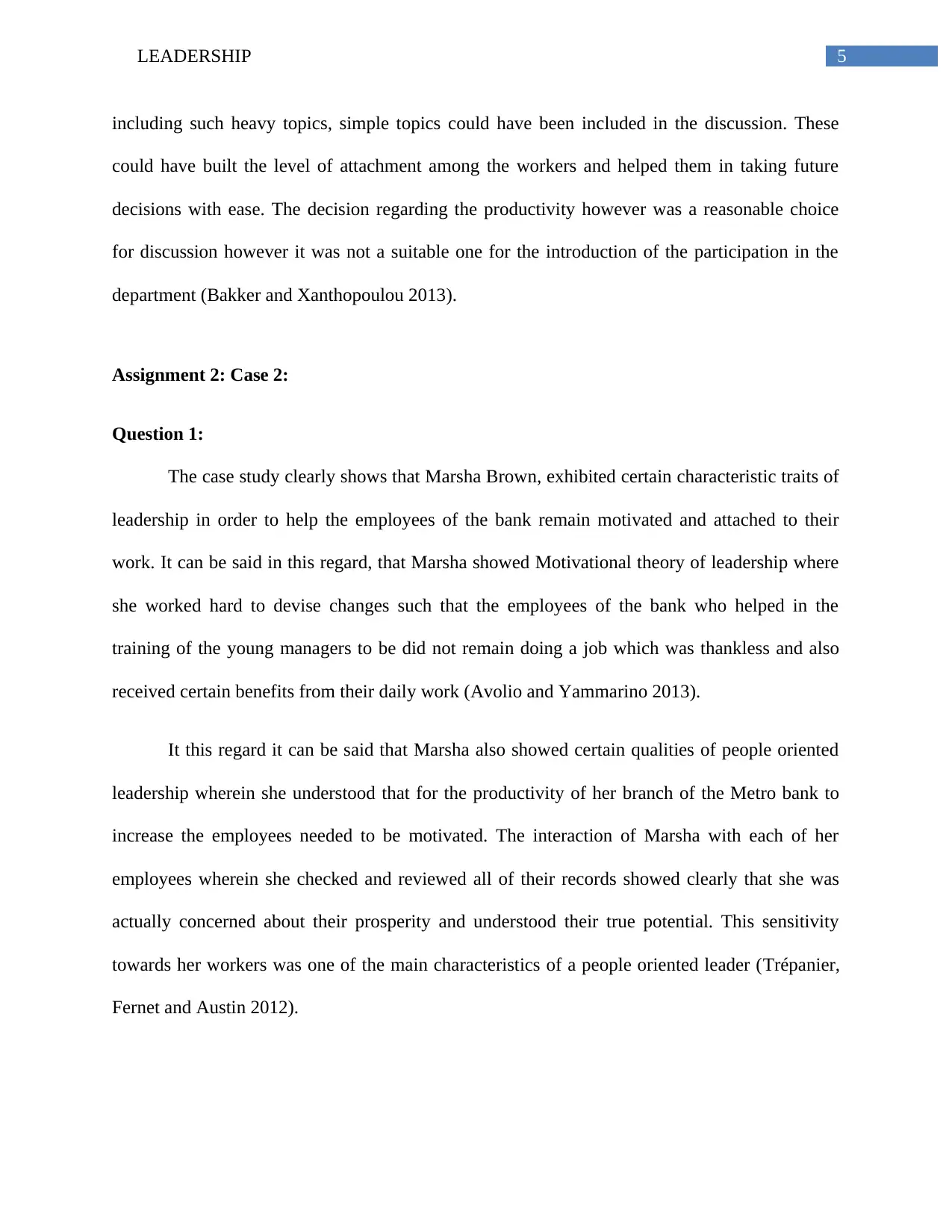
5LEADERSHIP
including such heavy topics, simple topics could have been included in the discussion. These
could have built the level of attachment among the workers and helped them in taking future
decisions with ease. The decision regarding the productivity however was a reasonable choice
for discussion however it was not a suitable one for the introduction of the participation in the
department (Bakker and Xanthopoulou 2013).
Assignment 2: Case 2:
Question 1:
The case study clearly shows that Marsha Brown, exhibited certain characteristic traits of
leadership in order to help the employees of the bank remain motivated and attached to their
work. It can be said in this regard, that Marsha showed Motivational theory of leadership where
she worked hard to devise changes such that the employees of the bank who helped in the
training of the young managers to be did not remain doing a job which was thankless and also
received certain benefits from their daily work (Avolio and Yammarino 2013).
It this regard it can be said that Marsha also showed certain qualities of people oriented
leadership wherein she understood that for the productivity of her branch of the Metro bank to
increase the employees needed to be motivated. The interaction of Marsha with each of her
employees wherein she checked and reviewed all of their records showed clearly that she was
actually concerned about their prosperity and understood their true potential. This sensitivity
towards her workers was one of the main characteristics of a people oriented leader (Trépanier,
Fernet and Austin 2012).
including such heavy topics, simple topics could have been included in the discussion. These
could have built the level of attachment among the workers and helped them in taking future
decisions with ease. The decision regarding the productivity however was a reasonable choice
for discussion however it was not a suitable one for the introduction of the participation in the
department (Bakker and Xanthopoulou 2013).
Assignment 2: Case 2:
Question 1:
The case study clearly shows that Marsha Brown, exhibited certain characteristic traits of
leadership in order to help the employees of the bank remain motivated and attached to their
work. It can be said in this regard, that Marsha showed Motivational theory of leadership where
she worked hard to devise changes such that the employees of the bank who helped in the
training of the young managers to be did not remain doing a job which was thankless and also
received certain benefits from their daily work (Avolio and Yammarino 2013).
It this regard it can be said that Marsha also showed certain qualities of people oriented
leadership wherein she understood that for the productivity of her branch of the Metro bank to
increase the employees needed to be motivated. The interaction of Marsha with each of her
employees wherein she checked and reviewed all of their records showed clearly that she was
actually concerned about their prosperity and understood their true potential. This sensitivity
towards her workers was one of the main characteristics of a people oriented leader (Trépanier,
Fernet and Austin 2012).
⊘ This is a preview!⊘
Do you want full access?
Subscribe today to unlock all pages.

Trusted by 1+ million students worldwide
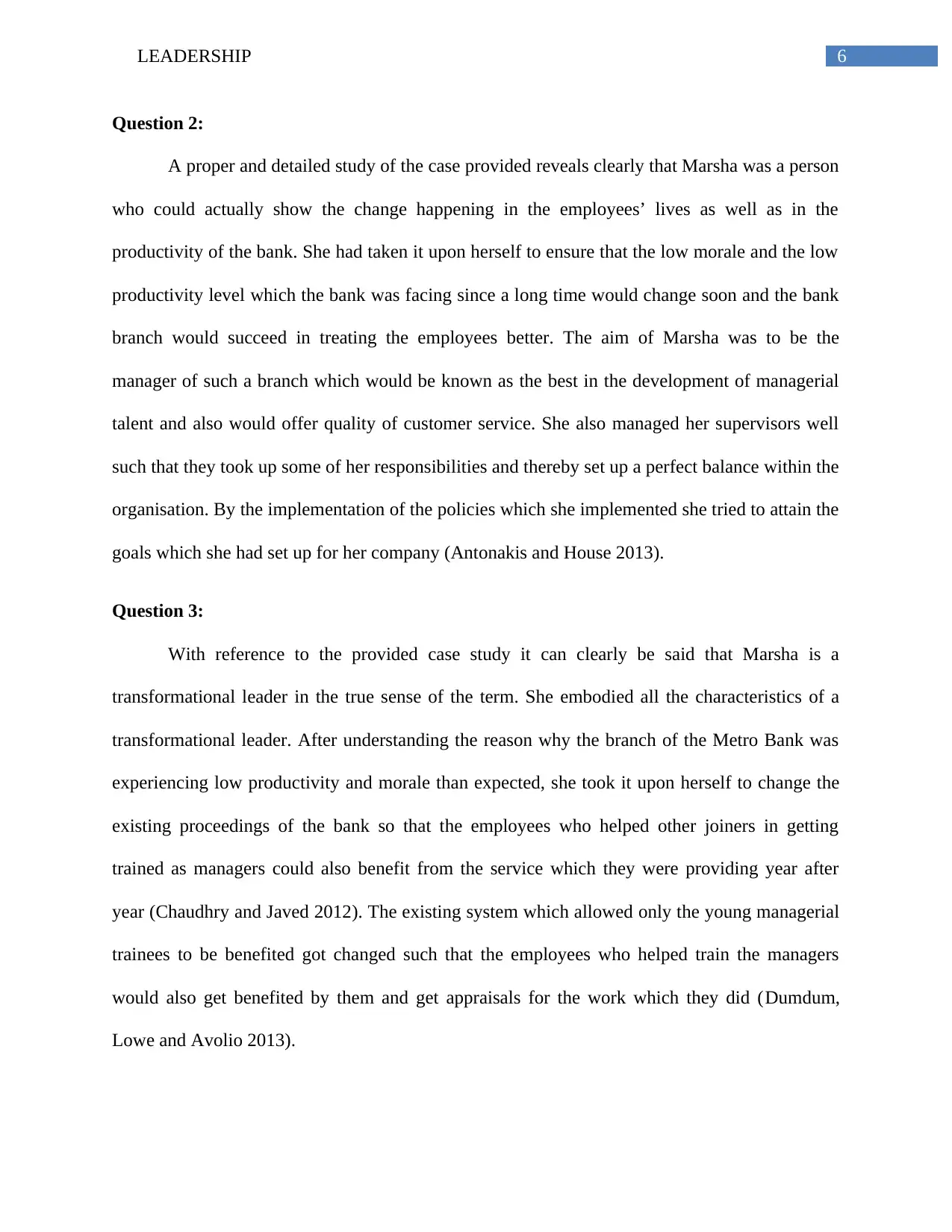
6LEADERSHIP
Question 2:
A proper and detailed study of the case provided reveals clearly that Marsha was a person
who could actually show the change happening in the employees’ lives as well as in the
productivity of the bank. She had taken it upon herself to ensure that the low morale and the low
productivity level which the bank was facing since a long time would change soon and the bank
branch would succeed in treating the employees better. The aim of Marsha was to be the
manager of such a branch which would be known as the best in the development of managerial
talent and also would offer quality of customer service. She also managed her supervisors well
such that they took up some of her responsibilities and thereby set up a perfect balance within the
organisation. By the implementation of the policies which she implemented she tried to attain the
goals which she had set up for her company (Antonakis and House 2013).
Question 3:
With reference to the provided case study it can clearly be said that Marsha is a
transformational leader in the true sense of the term. She embodied all the characteristics of a
transformational leader. After understanding the reason why the branch of the Metro Bank was
experiencing low productivity and morale than expected, she took it upon herself to change the
existing proceedings of the bank so that the employees who helped other joiners in getting
trained as managers could also benefit from the service which they were providing year after
year (Chaudhry and Javed 2012). The existing system which allowed only the young managerial
trainees to be benefited got changed such that the employees who helped train the managers
would also get benefited by them and get appraisals for the work which they did (Dumdum,
Lowe and Avolio 2013).
Question 2:
A proper and detailed study of the case provided reveals clearly that Marsha was a person
who could actually show the change happening in the employees’ lives as well as in the
productivity of the bank. She had taken it upon herself to ensure that the low morale and the low
productivity level which the bank was facing since a long time would change soon and the bank
branch would succeed in treating the employees better. The aim of Marsha was to be the
manager of such a branch which would be known as the best in the development of managerial
talent and also would offer quality of customer service. She also managed her supervisors well
such that they took up some of her responsibilities and thereby set up a perfect balance within the
organisation. By the implementation of the policies which she implemented she tried to attain the
goals which she had set up for her company (Antonakis and House 2013).
Question 3:
With reference to the provided case study it can clearly be said that Marsha is a
transformational leader in the true sense of the term. She embodied all the characteristics of a
transformational leader. After understanding the reason why the branch of the Metro Bank was
experiencing low productivity and morale than expected, she took it upon herself to change the
existing proceedings of the bank so that the employees who helped other joiners in getting
trained as managers could also benefit from the service which they were providing year after
year (Chaudhry and Javed 2012). The existing system which allowed only the young managerial
trainees to be benefited got changed such that the employees who helped train the managers
would also get benefited by them and get appraisals for the work which they did (Dumdum,
Lowe and Avolio 2013).
Paraphrase This Document
Need a fresh take? Get an instant paraphrase of this document with our AI Paraphraser
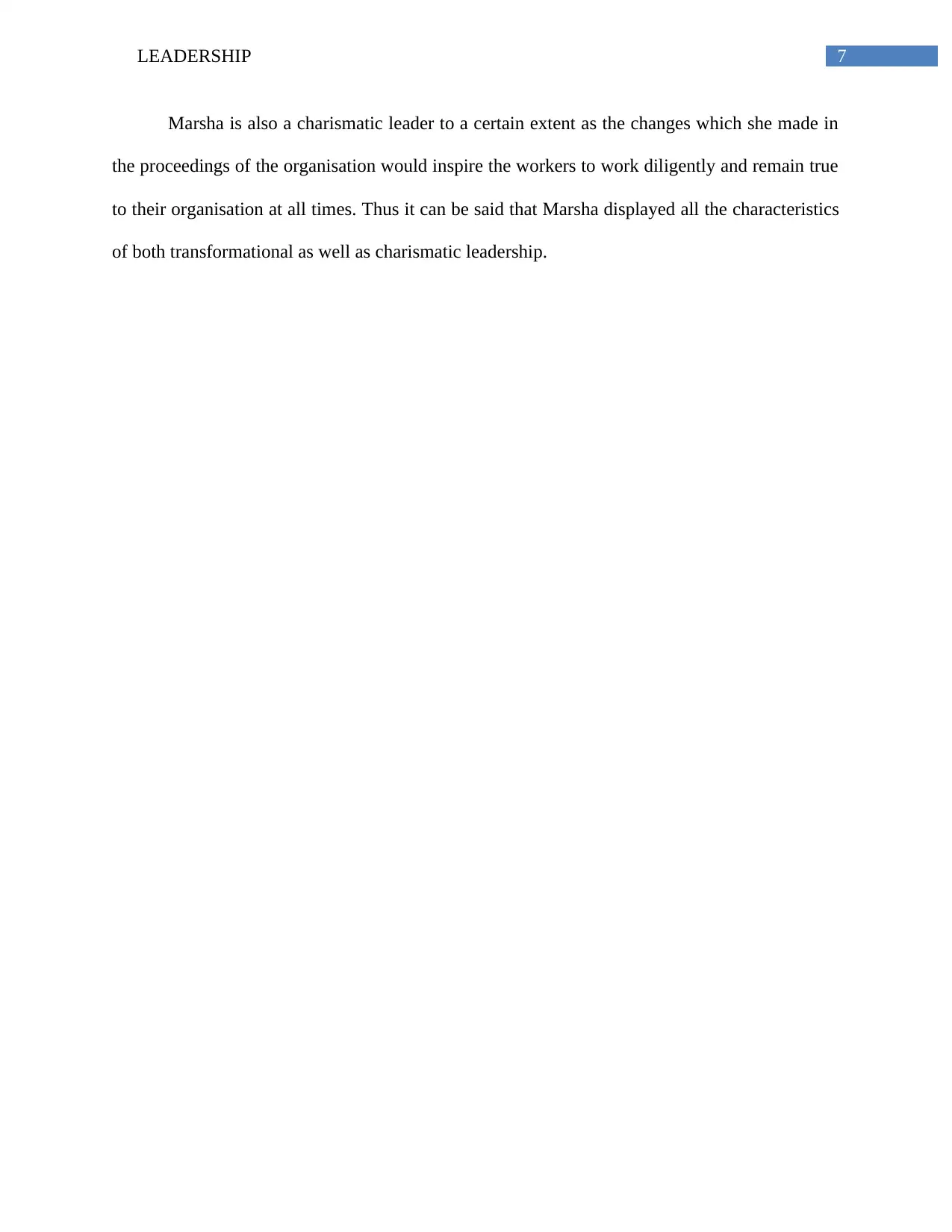
7LEADERSHIP
Marsha is also a charismatic leader to a certain extent as the changes which she made in
the proceedings of the organisation would inspire the workers to work diligently and remain true
to their organisation at all times. Thus it can be said that Marsha displayed all the characteristics
of both transformational as well as charismatic leadership.
Marsha is also a charismatic leader to a certain extent as the changes which she made in
the proceedings of the organisation would inspire the workers to work diligently and remain true
to their organisation at all times. Thus it can be said that Marsha displayed all the characteristics
of both transformational as well as charismatic leadership.
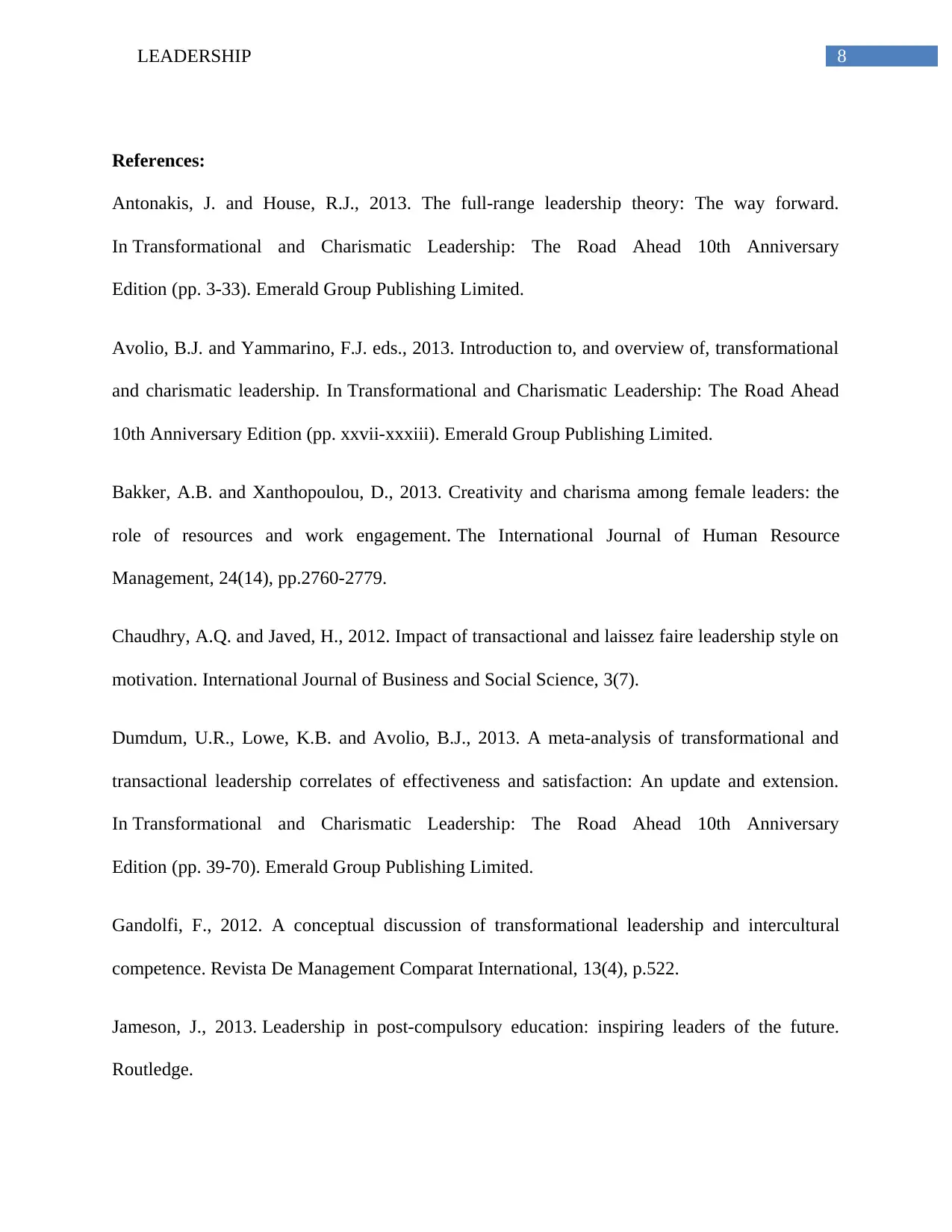
8LEADERSHIP
References:
Antonakis, J. and House, R.J., 2013. The full-range leadership theory: The way forward.
In Transformational and Charismatic Leadership: The Road Ahead 10th Anniversary
Edition (pp. 3-33). Emerald Group Publishing Limited.
Avolio, B.J. and Yammarino, F.J. eds., 2013. Introduction to, and overview of, transformational
and charismatic leadership. In Transformational and Charismatic Leadership: The Road Ahead
10th Anniversary Edition (pp. xxvii-xxxiii). Emerald Group Publishing Limited.
Bakker, A.B. and Xanthopoulou, D., 2013. Creativity and charisma among female leaders: the
role of resources and work engagement. The International Journal of Human Resource
Management, 24(14), pp.2760-2779.
Chaudhry, A.Q. and Javed, H., 2012. Impact of transactional and laissez faire leadership style on
motivation. International Journal of Business and Social Science, 3(7).
Dumdum, U.R., Lowe, K.B. and Avolio, B.J., 2013. A meta-analysis of transformational and
transactional leadership correlates of effectiveness and satisfaction: An update and extension.
In Transformational and Charismatic Leadership: The Road Ahead 10th Anniversary
Edition (pp. 39-70). Emerald Group Publishing Limited.
Gandolfi, F., 2012. A conceptual discussion of transformational leadership and intercultural
competence. Revista De Management Comparat International, 13(4), p.522.
Jameson, J., 2013. Leadership in post-compulsory education: inspiring leaders of the future.
Routledge.
References:
Antonakis, J. and House, R.J., 2013. The full-range leadership theory: The way forward.
In Transformational and Charismatic Leadership: The Road Ahead 10th Anniversary
Edition (pp. 3-33). Emerald Group Publishing Limited.
Avolio, B.J. and Yammarino, F.J. eds., 2013. Introduction to, and overview of, transformational
and charismatic leadership. In Transformational and Charismatic Leadership: The Road Ahead
10th Anniversary Edition (pp. xxvii-xxxiii). Emerald Group Publishing Limited.
Bakker, A.B. and Xanthopoulou, D., 2013. Creativity and charisma among female leaders: the
role of resources and work engagement. The International Journal of Human Resource
Management, 24(14), pp.2760-2779.
Chaudhry, A.Q. and Javed, H., 2012. Impact of transactional and laissez faire leadership style on
motivation. International Journal of Business and Social Science, 3(7).
Dumdum, U.R., Lowe, K.B. and Avolio, B.J., 2013. A meta-analysis of transformational and
transactional leadership correlates of effectiveness and satisfaction: An update and extension.
In Transformational and Charismatic Leadership: The Road Ahead 10th Anniversary
Edition (pp. 39-70). Emerald Group Publishing Limited.
Gandolfi, F., 2012. A conceptual discussion of transformational leadership and intercultural
competence. Revista De Management Comparat International, 13(4), p.522.
Jameson, J., 2013. Leadership in post-compulsory education: inspiring leaders of the future.
Routledge.
⊘ This is a preview!⊘
Do you want full access?
Subscribe today to unlock all pages.

Trusted by 1+ million students worldwide
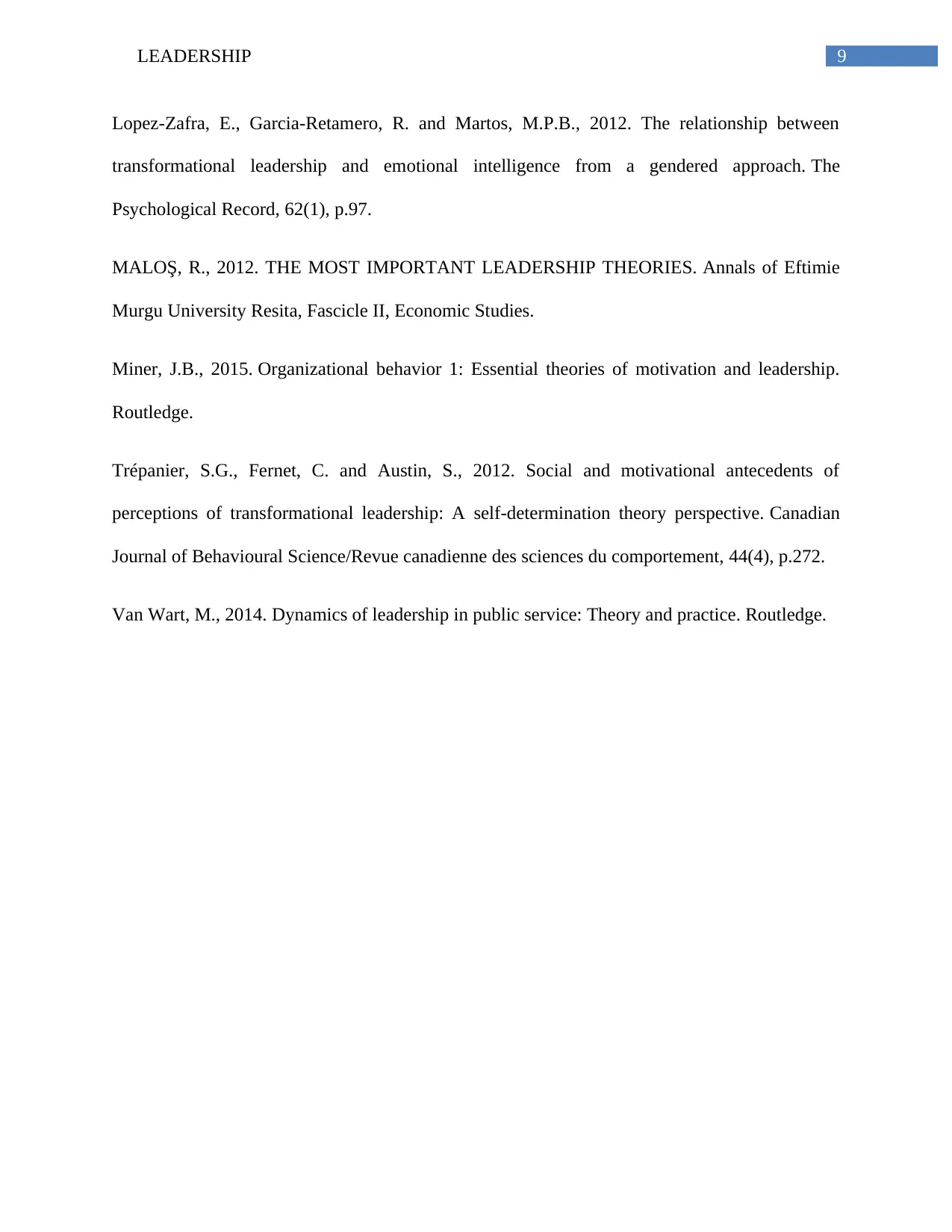
9LEADERSHIP
Lopez-Zafra, E., Garcia-Retamero, R. and Martos, M.P.B., 2012. The relationship between
transformational leadership and emotional intelligence from a gendered approach. The
Psychological Record, 62(1), p.97.
MALOŞ, R., 2012. THE MOST IMPORTANT LEADERSHIP THEORIES. Annals of Eftimie
Murgu University Resita, Fascicle II, Economic Studies.
Miner, J.B., 2015. Organizational behavior 1: Essential theories of motivation and leadership.
Routledge.
Trépanier, S.G., Fernet, C. and Austin, S., 2012. Social and motivational antecedents of
perceptions of transformational leadership: A self-determination theory perspective. Canadian
Journal of Behavioural Science/Revue canadienne des sciences du comportement, 44(4), p.272.
Van Wart, M., 2014. Dynamics of leadership in public service: Theory and practice. Routledge.
Lopez-Zafra, E., Garcia-Retamero, R. and Martos, M.P.B., 2012. The relationship between
transformational leadership and emotional intelligence from a gendered approach. The
Psychological Record, 62(1), p.97.
MALOŞ, R., 2012. THE MOST IMPORTANT LEADERSHIP THEORIES. Annals of Eftimie
Murgu University Resita, Fascicle II, Economic Studies.
Miner, J.B., 2015. Organizational behavior 1: Essential theories of motivation and leadership.
Routledge.
Trépanier, S.G., Fernet, C. and Austin, S., 2012. Social and motivational antecedents of
perceptions of transformational leadership: A self-determination theory perspective. Canadian
Journal of Behavioural Science/Revue canadienne des sciences du comportement, 44(4), p.272.
Van Wart, M., 2014. Dynamics of leadership in public service: Theory and practice. Routledge.
1 out of 10
Related Documents
Your All-in-One AI-Powered Toolkit for Academic Success.
+13062052269
info@desklib.com
Available 24*7 on WhatsApp / Email
![[object Object]](/_next/static/media/star-bottom.7253800d.svg)
Unlock your academic potential
Copyright © 2020–2025 A2Z Services. All Rights Reserved. Developed and managed by ZUCOL.





